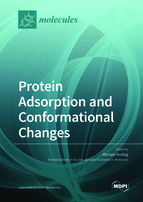Protein Adsorption and Conformational Changes
A special issue of Molecules (ISSN 1420-3049). This special issue belongs to the section "Bioorganic Chemistry".
Deadline for manuscript submissions: closed (31 July 2021) | Viewed by 21222
Special Issue Editor
Interests: biomolecular structure and dynamics; protein–surface interactions; misfolding; molecular recognition; biomolecular NMR spectroscopy; protein chemical modifications
Special Issues, Collections and Topics in MDPI journals
Special Issue Information
Dear Colleagues,
Protein adsorption to solids, nanomaterials, and biological surfaces is of central interest in many fields, including biomedicine, bioanalytical chemistry, materials engineering, bio-nanotechnology, as well as basic biomolecular research. Although protein adsorption may sometimes occur with little consequence on molecular structure, interactions with surfaces frequently cause changes in local or global conformations and dynamics, perturbations to secondary structures or tertiary folds, eventually resulting in dramatically altered protein function. Importantly, surfaces may trigger protein misfolding and self-aggregation, or, conversely, promote protein structure formation. The use of nanoscale surfaces to remodel the conformational landscape and the aggregation pathways of amyloidogenic peptides and proteins has been proposed as a promising strategy against several severe human diseases. The rapid growth of applications and technological innovation which is based on or concerned with protein adsorption necessitates renewed efforts to provide molecular level insight into adsorption-induced protein structural perturbations.
In this Special Issue, we aim to gather the most recent findings of experimental and computational investigations that contribute novel insight into protein adsorption with a focus on structural and dynamic aspects. Special emphasis will be placed on observations obtained with advanced technologies and approaches, on integrated experimental measurements/computational methods, submolecular level and biomolecular exchange studies, theoretical modeling, novel features of protein conformational landscapes, and the molecular basis of surface-mediated protein conformational transitions.
We welcome submissions of original research and reviews that address some aspect of the Special Issue’s theme.
Prof. Dr. Michael Assfalg
Guest Editor
Manuscript Submission Information
Manuscripts should be submitted online at www.mdpi.com by registering and logging in to this website. Once you are registered, click here to go to the submission form. Manuscripts can be submitted until the deadline. All submissions that pass pre-check are peer-reviewed. Accepted papers will be published continuously in the journal (as soon as accepted) and will be listed together on the special issue website. Research articles, review articles as well as short communications are invited. For planned papers, a title and short abstract (about 100 words) can be sent to the Editorial Office for announcement on this website.
Submitted manuscripts should not have been published previously, nor be under consideration for publication elsewhere (except conference proceedings papers). All manuscripts are thoroughly refereed through a single-blind peer-review process. A guide for authors and other relevant information for submission of manuscripts is available on the Instructions for Authors page. Molecules is an international peer-reviewed open access semimonthly journal published by MDPI.
Please visit the Instructions for Authors page before submitting a manuscript. The Article Processing Charge (APC) for publication in this open access journal is 2700 CHF (Swiss Francs). Submitted papers should be well formatted and use good English. Authors may use MDPI's English editing service prior to publication or during author revisions.
Keywords
- Protein adsorption
- Protein–surface interactions
- Conformational landscape
- Protein structure and dynamics
- Misfolding
- Nano–bio interface







